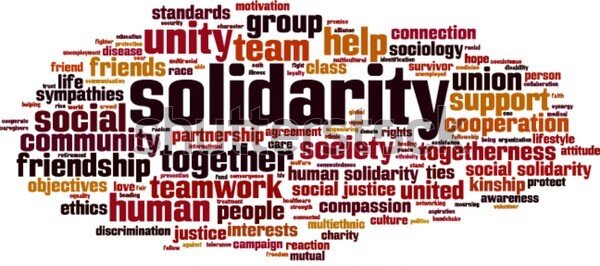What does Solidarity mean to you?
By Megan McCullough and Julia Lipkis
Our second WordView conversation was dedicated to the word “Solidarity.” People from around the world came together to discuss their understanding of the word, as well as their own personal stories, ideas, and opinions. This time, the group was a mix of familiar faces from the last session (“Divisions”) and new joiners, and the discussion was lively and far-ranging. Below are some of the main themes and questions brought up.
What does solidarity mean to you?
Julia: Many commented that for them, solidarity is first and foremost the act of standing with someone else. While solidarity is measured by one’s actions, the first step requires deep self-reflection. What are my values? How do my values inform the way in which I see others? During our discussion, one participant mentioned that you must be willing to use your own capital in order to truly stand in solidarity with others. Each one of us can contribute in unique and valuable ways. We simply need the courage to stay true to our values, and the compassion to understand the struggle of others.
Megan: I agree with Julia, many in the group emphasized that for them, solidarity is a verb—meaning it is an act that requires measurable actions. We do not just stand in solidarity with another, but rather engage in an act of solidarity. For as we at Compassionate Courage define solidarity, it is an act that requires us to take sides, to stand up, to speak out when we witness injustice. While some saw the concept of solidarity as belonging solely to the realm of the political, others did not see a difference between acting in solidarity with an individual vs. a larger political movement. For to borrow the rallying slogan of both student activists and second-wave feminists, the personal is political. As Julia mentioned above, to act in solidarity requires us, as individuals, to adhere to and act from an internal set of values. We have to be willing to put ourselves in uncomfortable situations in order to stand up for those values.
What is the difference between solidarity and allyship?
Julia: We spoke about solidarity and allyship as concepts within an overlapping Venn diagram, where empathy and understanding are at the intersection. For instance, one can "stand in solidarity” with members of the Asian community after upsetting reports of hate crimes, or with indigenous groups who have lost their land. Solidarity is a call to action in response to (or in opposition towards) a specific event or concern. Many participants considered allyship to be more of a personal, invisible process by which we learn how to support our friends, coworkers, or others on a daily basis. Allyship is a lifelong process of discovery with no specific goal or conclusion in mind. True solidarity requires allyship.
Megan: As Julia mentions above, what at first glance appear to be synonyms, the words allyship and solidarity seemingly echo the split between acting in solidarity with an individual vs. a larger political movement. Some participants felt strongly in favor of the word allyship, with one member of the group recounting the story of his attempt to translate allyship into different languages. Ultimately, they settled on using the word “friendship” in place of “allyship,” and noted that in Chinese, “friendship” literally translates as “two hands.” The image of two interlocking hands is often used to signify solidarity. Others advocated for solidarity wanting to bring in the element of politics, suggesting that solidarity can play a greater role in structural change.
What is the best way to stand in solidarity with someone else?
Julia: “What do I do to help?” is a question often asked by empathetic people who want to stand up for a cause but don’t know how or where to start. While it comes from a well-meaning place, this cry into the wilderness can be emotionally exhausting and frustrating to hear for people and groups seeking true solidarity and support. During my master’s program, I worked with a team of graduate students to create and conduct a survey, with the goal of understanding the community’s response to police violence. During one contentious meeting, a community member raised her hand. Clearly frustrated, she stated, “you keep asking what you can do, but you aren’t really hearing us.” Instead of demanding answers, perhaps we can reframe our appeal: “Let’s talk about what’s going on.”
Megan: One approach that was repeatedly stressed during our session, was the importance of asking the community, or the individual, with whom you want engage in solidarity, what solidarity looks like for them. In my experience developing both human rights advocacy campaigns and community engagement projects for a non-profit museum, ascertaining the needs of the community you seek to serve is step number one, crucial to the long-term success of any campaign/project. Needs determine goals and those goals should align with your organization’s overall mission. Even on the individual level, this is a roadmap for solidarity. Instead of a mission statement, we have values—the very values that motivate us to act in solidarity with others. However, if we fail to prioritize the needs of those whom we wish to show solidarity for, we run the risk of at best, appearing out of touch or ineffective, and at worst, coming across as the patronizing “great white savior,” who ultimately does more harm than good.


